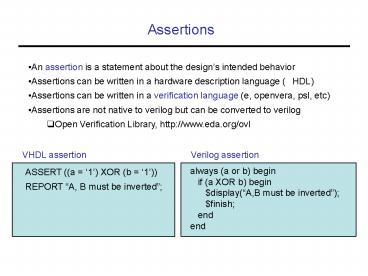Assertions PowerPoint PPT Presentation
Title: Assertions
1
Assertions
- An assertion is a statement about the designs
intended behavior - Assertions can be written in a hardware
description language (HDL) - Assertions can be written in a verification
language (e, openvera, psl, etc) - Assertions are not native to verilog but can be
converted to verilog - Open Verification Library, http//www.eda.org/ovl
VHDL assertion
Verilog assertion
always (a or b) begin if (a XOR b) begin
display(A,B must be inverted) finish
end end
ASSERT ((a 1) XOR (b 1)) REPORT A, B
must be inverted
2
Benefits of Assertions
- Improved Observability
- Internal variables and be observed with less
effort - Reduce Debug Time
- Errors can be detected close to when/where they
occur - Easier to track down the source of a bug
- Facilitates Design Integration
- Assertions at module interface defined before
implementation - Interface assertions act as verifiable contracts
- Facilitates Designers Understanding
- The designer must fully understand his/her module
to write assertions - Many inconsistencies are found in the process of
writing assertions
3
Assertion Rules of Thumb
- Create assertions for identified errors not
detected by existing assertions - Attempt to make the assertion set complete
- Give assertions good names (or good comments)
- Need to understand the meaning of assertions to
make a complete set - Provide a consistent way to disable assertions
- Assertion evaluation is slow
- Do not synthesize assertions
- Assertions are usually for simulation, not
silicon debug
4
Classes of Assertions/Properties
Safety Property
- States that a property should be true at all
times - May involve a finite time window
- Ex. 1 At a traffic intersection, no more than one
light should be GREEN or YELLOW at a time. - Ex. 2 If a light is YELLOW at time T then it
should be RED no later than time T3.
Liveness Property
- States that a property must eventually become
true, under a condition - No limit on time
- In practice, there is usually a time limit
- Ex. A traffic light must eventually become green
if a car is waiting
5
Assertions in Verilog
- We will use Open Verilog Library (OVL) since
assertions are not native to Verilog
- An assertion for a FIFO
- pop input signal
- cnt is the number of elements in the FIFO
assert_never no_underflow (clk, reset, (pop
cnt0))
- Assertion name is no_underflow
- clk and reset are the clock and reset signals
(needed to indicate when to evaluate the
assertion) - (pop cnt0) is the boolean which cannot
evaluate to true
6
Temporal OVL Assertion
The ack signal must be asserted exactly three
clock cycles after the req signal is asserted
assert_next (0,3) my_req_ack (clk, reset, req,
ack)
num_cks
start_event
test_expr
severity
- Severity indicates what to do when assertion is
violated (0stop sim) - Start_event is the event that triggers the
monitoring of the test_expr - Test_expr is the expression which must be TRUE
num_clks after the trigger
7
Assertions as Constraints on the State Space
- The set of all net/variable values defines a
system state - The cross product of all net/variable values
defines the state space - Some of the state space is not feasible because
some variable combinations cannot happen (two
traffic lights green together) - An assertion is a constraint which partially
defines the feasible state space
8
Assertions for the Traffic Light Controller
- Traffic Light Controller
- Two main variables, NS and EW
- Each variable has 3 possible values, R, G, B
- State space has 9 elements (3x3)
- Select assertions to minimize intersection
- A1 is not needed

